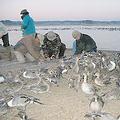 根據最新研究,野生候鳥可能是禽流感病毒跨洲散播的主要帶原者,科學家說,這個發現對於監控北美洲高致病型禽流感有重要意義。
根據最新研究,野生候鳥可能是禽流感病毒跨洲散播的主要帶原者,科學家說,這個發現對於監控北美洲高致病型禽流感有重要意義。
美國地質調查局(USGS)的科學家與阿拉斯加的美國漁業暨野生物管理局(U.S. Fish and Wildlife Service)及東京大學合作,透過基因方面的證據,發現尖尾鴨(northern pintail)將亞洲的禽流感病毒帶到阿拉斯加。
研究作者之一,USGS野生動物健康中心的野生動物研究生物學家法蘭森(Chris Franson)表示,「雖然過去有些研究推測,野鳥由亞洲跨洲傳播禽流感到北美屬於罕見現象,本項研究提出了對立的觀點。」
法蘭森說,以往研究所針對的鳥類,並不是跨洲遷徙的候鳥,或者僅屬於北美中緯度的留鳥,這些區域距離亞洲禽流感病株的發源地都很遠。
在這項研究中,USGS的科學家與漁業暨野生物管理局、當地州政府及原住民社區合作,從阿拉斯加共1400隻以上的尖尾鴨身上採取樣本。
禽流感病毒具有的基因片段中,有8種與亞洲的禽流感病株關係較近,而與北美的病株關係較遠。科學家發現,阿拉斯加野生尖尾鴨身上的「低致病型」禽流感病毒,近半數至少擁有1種與亞洲病株比較接近的基因片段。
但是沒有任何樣本的病毒與亞洲病株完全一致,也沒有發現「高致病型」病毒。低致病型禽流感對鳥類通常只引發輕微的症狀,例如羽毛蓬起、產蛋率降低等,而且容易受到忽略。
高致病型禽流感的影響則非常猛烈,不但會在群聚的家禽之間迅速傳播,染病後還影響數種體內器官,而且通常不到48小時就有100%的致死率。
在家禽密集飼養的擁擠環境中,野鳥帶有的某些H5與H7亞型病毒會演化成高致病型禽流感病毒。過去10年間,就是高致病型的H5N1禽流感病毒由亞洲散布到歐洲、非洲,使得數億雞鴨遭到撲殺,並造成245人死亡,令人憂心病毒可能在人與人之間爆發傳染。
正常狀況下,人類不會感染禽流感病毒,但曾有幾個案例,是特定的高致病型病毒造成嚴重的人類呼吸道疾病。絕大多數情況下,感染病毒的人都曾密集接觸過染病的家禽,或接觸過被染病家禽糞便污染的物品。
研究H5N1亞型病毒是否可能由野鳥跨洲傳播的科學家,對於候鳥在傳播高致病型病毒到其他區域所扮演的角色,一直未有定論。
研究的另一位作者,USGS阿拉斯加中心的野生動物研究生物學家皮爾斯(John Pearce)指出,「本研究分析野鳥身上常見的低致病型病毒,類似的基因分析方法,假如針對恰當的鳥種與區域進行採樣,不但可以解答野鳥遷徙的問題,還能了解病毒跨洲交換的程度。」
這項研究本週發表於《分子生態學》期刊。
Wild migratory birds appear to be important carriers of avian influenza viruses from continent to continent, according to new research that scientists say has important implications for highly pathogenic avian influenza virus surveillance in North America.
Scientists with the U.S. Geological Survey, in collaboration with the U.S. Fish and Wildlife Service in Alaska and the University of Tokyo, have found genetic evidence that northern pintail ducks carried Asian forms of avian influenza to Alaska.
"Although some previous research has led to speculation that intercontinental transfer of avian influenza viruses from Asia to North America via wild birds is rare, this study challenges that," said Chris Franson, a research wildlife biologist with the USGS National Wildlife Health Center and co-author of the study.
Most previous studies examined bird species that are not transcontinental migrants or were from mid-latitude locales in North America, regions far removed from sources of Asian strains of avian influenza, said Franson.
For this study, scientists with the USGS, in collaboration with the U.S. Fish and Wildlife Service, state agencies, and Alaska native communities, obtained samples from more than 1,400 northern pintails from locations throughout Alaska.
The scientists observed that nearly half of the low pathogenic avian influenza viruses found in wild northern pintail ducks in Alaska contained at least one of eight gene segments that were more closely related to Asian than to North American strains of bird flu.
None of the samples were found to contain completely Asian-origin viruses and none were highly pathogenic. The low pathogenic form of the disease commonly causes only mild symptoms such as ruffled feathers and a drop in egg production, and may easily go undetected.
The highly pathogenic form is far more dramatic. It spreads very rapidly through poultry flocks, causes disease affecting multiple internal organs, and has a mortality that can approach 100 percent, often within 48 hours.
Under the crowded conditions of intensive poultry farming, some variants of the H5 and H7 viral subtypes derived from wild birds can evolve into highly pathogenic avian influenza viruses.
It was a highly pathogenic form of the H5N1 bird flu virus that spread across Asia to Europe and Africa over the past decade, causing the culling of hundreds of millions of chickens and ducks, and the deaths of 245 people, raising concerns of a possible human pandemic.
Avian influenza viruses do not normally infect humans but there have been instances of certain highly pathogenic strains causing severe respiratory disease in humans. In most cases, the people infected had been in close contact with infected poultry or with objects contaminated by their feces.
The role of migratory birds in moving the highly pathogenic virus to other geographic areas has been a subject of disagreement among scientists that focused on how likely it is for H5N1 to disperse across continents via wild birds.
"This kind of genetic analysis - using the low pathogenic strains of avian influenza virus commonly found in wild birds - can answer questions not only about the migratory movements of wild birds, but the degree of virus exchange that takes place between continents, provided the right species and geographic locations are sampled," said John Pearce, a research wildlife biologist with the USGS Alaska Science Center and co-author of the study.
The study is published this week in the journal "Molecular Ecology."
全文及圖片詳見:ENS


